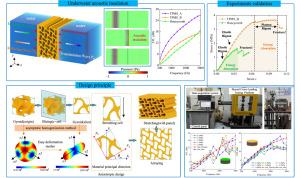Pressure-resistant metastructures based on sliced-TPMS lattices for waterborne sound insulation
IF 9.4
1区 工程技术
Q1 ENGINEERING, MECHANICAL
International Journal of Mechanical Sciences
Pub Date : 2025-09-23
DOI:10.1016/j.ijmecsci.2025.110851
引用次数: 0
Abstract
Effective sound insulation in water often needs low impedance materials. The inherent conflict between low impedance and high stiffness presents considerable challenges in designing pressure-resistant sound insulation structures for underwater applications. Numerous studies have demonstrated that triply periodic minimal surface (TPMS) structures exhibit excellent mechanical properties, making them suitable for designing pressure-resistant structures. However, it remains unclear whether they can be utilized for underwater sound insulation. This work presents a novel design framework of pressure-resistant metastructures based on sliced-TPMS lattices for waterborne sound insulation. Eigenvalue analysis of the effective elastic matrix of typical TPMS structures shows that they do not possess easy deformation modes, which are crucial for achieving low impedance. A slicing design based on Gyroid lattices is introduced to release an easy deformation mode of the metastructure. Additionally, the balance between low impedance and pressure resistance is achieved through anisotropic design involving stretching the unit cell and rotating the material principal direction. A semi-analytical method that integrates the transition matrix method with asymptotic homogenization is developed to calculate the acoustic and mechanical properties of the metastructure efficiently. The results of mechanical and acoustic experiments demonstrates that the optimized anisotropic sliced-TPMS metastructure (with a thickness of 45 mm) can achieve exceptional sound insulation performance in the low-frequency broadband range (an average sound transmission loss of 9.2 dB across 200 Hz to 3000 Hz) under high hydrostatic pressure conditions (3MPa).

基于片状tpms晶格的水基隔声耐压元结构
在水中有效的隔声往往需要低阻抗材料。低阻抗和高刚度之间的内在冲突给水下应用的耐压隔声结构设计带来了相当大的挑战。大量研究表明,三周期最小表面(TPMS)结构具有优异的力学性能,适合设计耐压结构。然而,目前还不清楚它们是否可以用于水下隔音。本文提出了一种基于片状tpms晶格的抗压元结构设计框架,用于水性隔声。典型TPMS结构的有效弹性矩阵特征值分析表明,TPMS结构不具有易变形模式,这是实现低阻抗的关键。引入了一种基于陀螺晶格的切片设计,以释放易变形的元结构模式。此外,通过拉伸单元胞和旋转材料主方向的各向异性设计,实现了低阻抗和耐压之间的平衡。提出了一种将过渡矩阵法与渐近均匀化相结合的半解析方法,以有效地计算元结构的声学和力学性能。力学和声学实验结果表明,在高静水压力(3MPa)条件下,优化后的各向异性切片tpms元结构(厚度为45 mm)在低频宽带范围内具有优异的隔声性能(200 Hz ~ 3000 Hz的平均声传输损失为9.2 dB)。
本文章由计算机程序翻译,如有差异,请以英文原文为准。
求助全文
约1分钟内获得全文
求助全文
来源期刊

International Journal of Mechanical Sciences
工程技术-工程:机械
CiteScore
12.80
自引率
17.80%
发文量
769
审稿时长
19 days
期刊介绍:
The International Journal of Mechanical Sciences (IJMS) serves as a global platform for the publication and dissemination of original research that contributes to a deeper scientific understanding of the fundamental disciplines within mechanical, civil, and material engineering.
The primary focus of IJMS is to showcase innovative and ground-breaking work that utilizes analytical and computational modeling techniques, such as Finite Element Method (FEM), Boundary Element Method (BEM), and mesh-free methods, among others. These modeling methods are applied to diverse fields including rigid-body mechanics (e.g., dynamics, vibration, stability), structural mechanics, metal forming, advanced materials (e.g., metals, composites, cellular, smart) behavior and applications, impact mechanics, strain localization, and other nonlinear effects (e.g., large deflections, plasticity, fracture).
Additionally, IJMS covers the realms of fluid mechanics (both external and internal flows), tribology, thermodynamics, and materials processing. These subjects collectively form the core of the journal's content.
In summary, IJMS provides a prestigious platform for researchers to present their original contributions, shedding light on analytical and computational modeling methods in various areas of mechanical engineering, as well as exploring the behavior and application of advanced materials, fluid mechanics, thermodynamics, and materials processing.
 求助内容:
求助内容: 应助结果提醒方式:
应助结果提醒方式:


